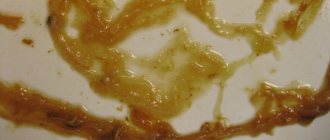Laboratory methods for examining urine are an important stage of a medical examination, allowing us to learn more about the health of the child. This analysis is prescribed for all children, from infants to adolescents 12 years of age and older.
In addition to routine testing, the presence of mucus in it may be a reason for submitting urine for testing. Mucus in a child’s urine causes great concern for the baby’s parents, as it may indicate possible problems in the child’s body. In order not to get confused in such a case, every parent needs to know the reasons for this phenomenon and what needs to be done in such a situation.
Is mucus in the urine normal or pathological?
Normally, the human body constantly produces mucus. In the urinary system, it is produced in goblet cells that line the mucous membrane of the urinary organs. This secretion performs a protective function, preventing the mucous layer from being destroyed from the negative effects of urine and other components contained in it. In some conditions, urine contains components that are dangerous to the mucous membrane, for example, in infectious pathologies or during treatment with chemotherapy. If there was no mucus, pathogenic microflora could easily penetrate the walls of the bladder and urethra.
An important function of mucus is to reduce the activity of pathogenic bacteria. It has been proven that pathogenic microorganisms develop rapidly on the mucous membrane of human internal organs. The secret prevents viruses and bacteria from penetrating into tissues. Consequently, mucus protects the child’s urinary system from painful microflora.
According to the recommendations of the World Health Organization (WHO), normally the secretion is not visualized in the urine of a child or adult. If this sign clearly makes itself felt, you should definitely undergo a comprehensive medical examination.
Functions of mucus in the body
Mucus is produced by special goblet cells in the epithelium of the urinary tract. The main purpose of mucus is a protective function aimed at preserving the internal surface of organs from the irritating effects of urea and the acidic reaction of urine.
In a healthy body, enough mucus is synthesized to neutralize the aggression of urine, as well as urea. As is normal, a small amount is excreted into the urine stream, which is determined only by laboratory urine testing.
How is mucus visualized in a child’s urine?
Parents should be sure to pay attention to the color and consistency of their child's urine. You can see threads of mucus without the help of various devices if you look closely. It may look like threads or small fibers with a milky or pronounced white tint. The urine itself acquires a cloudy consistency. The diameter of the threads and strands is approximately 0.5-1 mm, and the length is up to 5 mm.
In some diseases, urine develops a rather unpleasant odor. Threads of mucus are suspended, do not settle, but float in the urine. Particular attention should be paid if the urine contains greenish or bloody flakes. In such a situation, you should immediately go to the hospital. Bloody streaks indicate bleeding from internal organs, and greenish flakes indicate a purulent disease.
If the mucous secretion in a child’s urine is present in small quantities, it cannot be visualized without special medical equipment.
What to do if the analysis is bad?
Mucus, bacteria, protein and white blood cells in the urine are a cause for concern, but not for panic. The results of the study may not be indicative if the rules for collecting urine were violated. One way or another, the doctor will prescribe a repeat test, conduct additional examinations, and prescribe blood donation.
Usually one type of bacteria is found in urine. A mixed culture of microorganisms is a reason to repeat the study.
If leukocytes are found in the analysis of a pregnant woman, then she must be placed in a hospital under the supervision of two specialists: a gynecologist and a nephrologist. What you definitely shouldn’t do if the test results are bad is panic and self-medicate. Drugs prescribed by doctors and taken under their supervision guarantee minimal harm to the child and increase the possibility of a favorable pregnancy outcome.
Mucus is normally secreted in small quantities and performs a protective function. The appearance of mucus in large quantities indicates the presence of an inflammatory process in the kidneys, bladder or excretory tract. Also, an increased amount of mucus may appear as a result of violation of the rules for collecting samples for analysis. The level of mucus in urine is not an accurate indicator. To assess the size of detected mucus, a system of four pluses is used. A small amount of mucus is rated as a plus. The amount of mucus that is noticeable in the sample for analysis with the naked eye is indicated by four pluses (++++).
Reasons for the appearance of mucus in a urine test:
- urolithiasis disease;
- cystitis;
- sexually transmitted infections;
- prostatitis;
- kidney and bladder tumors;
- gynecological diseases;
Only after accurately determining the cause of poor tests and determining the diagnosis, the doctor can prescribe treatment. In order to prescribe correct and effective treatment, the doctor must be confident in the accuracy and precision of the test performed.
Urinalysis: norms and deviations
As already mentioned, mucus in the absence of any pathologies cannot be seen in urine with the naked eye. This indicates a small amount, so there is no need to worry. In accordance with international recommendations, a child should undergo a urine test twice a year during preventive examinations.
You might be interested in: Phimosis in boys
Rules for collecting urine for laboratory testing
To obtain reliable results during urine testing, it is recommended to correctly collect biological material. In this case, the following rules should be observed:
- It is better to collect flour in a special container, which can be purchased at any pharmacy.
- You can buy a urine collector for your baby, which will greatly simplify the task of collecting biological material.
- It is recommended to collect urine in the morning, immediately after sleep. This is due to the fact that 5-6 hours should pass from the last urination.
- Before the procedure, you should thoroughly wash the baby and pat his genitals well with a clean towel.
- Open the urine collection container immediately before collecting urine and immediately close it after the procedure is completed.
- The test material must be delivered to the laboratory no later than 2 hours later. In this case, the temperature should not exceed 25 °C. In summer, the container needs to be taken to the hospital faster.
Following these simple recommendations will help you get an objective assessment of your baby’s health.
This is necessary for the correct diagnosis of certain pathologies and the choice of their treatment.
Interpretation of test results
In the table we suggest considering the possible results of laboratory research. The “mucus” column may contain the following indicators.
| Mucus in urine is not detected | Indicates absence of mucus |
| Traces are found | Mucus in the urine was detected in negligible quantities, which corresponds to the norm |
| Number 1 | Indicates the presence of secretion, which corresponds to the age of the patient |
| + | Slight excess of the norm. Sometimes this indicator occurs when there is a violation of urine collection for analysis. |
| Increased quantity | Exceeding normal values, which indicates the presence of a particular disease |
| ++++ | Maximum excess amount of mucus, which indicates serious pathologies in the child |
When identifying renal epithelium, we are often talking about a disease such as glomerulonephritis. This type of secretion is allowed in infants in the first weeks of life.
Prevention
Often mucus in the urine of adults and children does not appear because the person is seriously ill. The reason is much more prosaic - simple non-compliance with the rules for collecting samples for analysis. To avoid mistakes, read these simple instructions and follow them:
- A few days before the analysis, start following a diet (do not eat spicy, salty, fried foods or colored foods),
- Collect urine in the morning immediately after waking up,
- Before collecting material, thoroughly wash your genitals and dry them with a clean towel,
- To prevent discharge from getting into the urine, women are advised to close the vaginal opening with a cotton swab.
- Buy containers for collecting material at a pharmacy or carefully wash and sterilize before using it,
- Collected urine should be stored for no more than 2 hours in a dark, cool place before being sent to the laboratory.
- Refuse to have sex, and if an infection is detected, systematically use a condom until the end of treatment so as not to infect your partner.
Be healthy!
Why does mucus appear in the urine of children?
All reasons for the appearance of pathological secretions in a child’s urine can be divided into external and internal. External ones have no relation to the functioning of internal organs. Internal ones indicate diseases of the genitourinary system. Let's look at the provoking factors in more detail.
Internal reasons
Internal causes of mucus in urine include the following conditions in children:
- Inflammatory diseases affecting the kidneys. More often these are diseases such as glomerulonephritis, pyelonephritis and others. Renal epithelium will be detected in the urine.
- Cystitis, urethritis and other bladder diseases. Due to the fact that pathogenic microflora is present in the body, mucus will be produced in increased quantities, because the mucous layer will try to suppress the painful microflora. In this case, a urine test in a child will show a significant excess of the norm. Leukocytes will also be elevated.
- In a boy, a pathology such as phimosis often becomes a permanent increase in the amount of mucus. In this case, the secretion accumulates under the foreskin and enters the urine when urinating.
- In girls, the disorder is observed in diseases such as vaginitis and vulvitis. Inflammatory pathologies of the female organs can also be provoked by fungi, streptococci, E. coli and other pathogenic agents.
You may be interested in: Glomerulonephritis in a child
From the list it is clear that all of these conditions affect internal organs. This applies to kidney and bladder diseases.
Let's look at external reasons as well.
External provoking factors
Among the external reasons for the appearance of mucus in the urine of a child, the following provoking factors should be noted:
- Failure to comply with the rules when collecting biological material for research.
- Violation of the rules for transporting urine.
- Insufficient genital hygiene during the test.
- Too much hygiene. For example, if a girl is washed too often, this causes the natural microflora to dry out, which can lead to the appearance of mucus.
- Improper washing, which especially concerns girls. When the intestinal environment comes into contact with the vaginal microflora, negative consequences occur. Among them are the development of infectious diseases and dysbacteriosis. Girls should be washed strictly from front to back.
- Prolonged absence of urination. If the act of excreting urine is delayed or if the baby has not gone to the toilet all night, a small amount of mucus may well be observed in the urine.
- Use of medications. Some medications lead to a decrease in urination, resulting in urinary stagnation.
Another external reason for the appearance of mucus in a child’s urine is improper drinking regimen. In this case, the secretion is usually found in small quantities. Insufficient fluid intake leads to the formation of salts and the development of the inflammatory process against this background.
The same consequences can be caused by poor nutrition and the presence of certain foods in the diet (sausages, canned food, mayonnaise, spicy ketchups, seasonings).
Norm of mucus and its excess
A healthy adult should have no mucus in their urine at all. Only a little clear mucus is allowed if other indicators are normal. But when it is detected in large quantities for the first time, a repeat study is usually prescribed. Only when the results are confirmed can the doctor conclude about the presence of pathology.
When interpreting test results, the laboratory technician uses certain criteria. There are four levels of mucus presence, which are indicated by a “+” sign:
- normal state of mucus in urine – 1+;
- mucus in urine 2+ means a moderate amount;
- an increased level is indicated by three pluses;
- if there are 4 pluses next to the word mucus on the analysis form, this means that there is a lot of it and special treatment is required.
If there is a high level of mucus, it can even be detected visually. The urine becomes cloudy and contains sediment. Sometimes clearly visible flakes of mucus may appear. This condition most often indicates a serious inflammatory process, in which the body intensively produces mucus to protect the organs from the penetration of bacteria.
And a moderate increase in the level of mucus almost does not manifest itself externally. The patient can only feel the symptoms caused by the pathologies that cause this condition. If such sensations appear, it is advisable to undergo an examination in order to take timely measures to eliminate the disease. Most often, this is a violation of urination: retention, too frequent, strong urges that do not lead to the release of urine, urinary incontinence. When urinating, a burning sensation, stinging or pain may occur. Sometimes itching of the external genitalia, rash, redness, discomfort during sexual intercourse and pain in the lower abdomen also occur.
Diagnostics
If mucus is detected in a child’s urine, do not delay a visit to your local pediatrician. An immediate visit to a doctor should be made when a small patient’s health worsens, fever, abdominal pain, malaise and other negative symptoms appear.
After passing a urine test, the specialist will send the child to doctors with a more specialized profile, for example, a urologist, gynecologist or surgeon. In addition to a general urine test, the patient may be prescribed the following studies:
- Smear of vaginal microflora in girls.
- Blood test, general and biochemical.
- Ultrasound examination of the genitourinary system.
If a preschooler or teenager is found to have a large amount of mucus (two pluses or more), it is necessary to immediately look for the cause of this deviation.
Treatment is selected depending on the results obtained during the tests. In addition, the doctor decides where the child will be during therapy (treatment at home or in a hospital).
You might be interested in: How to cure cystitis in a child
Symptoms
Mucus in a urine test is a symptom that you definitely need to pay attention to. Although its very appearance may go unnoticed by a person, the disease developing against this background will certainly be accompanied by characteristic pain when urinating, pain in the lower abdomen, increased body temperature and other signs.
Problems of the genitourinary system, for which mucus in a urine test is a characteristic sign, can also give rise to other symptoms: headaches, sleep disorders, high blood pressure, nausea, vomiting, loss of appetite, weakness, swelling of the arms and legs, chills, dry skin, seizures, etc. However, only a specialist should give a final conclusion about the causes of the disease and select treatment!
Treatment methods
As already mentioned, treatment if mucus is detected in the urine will depend on the diagnosis made during the examination.
Urinary tract infections
For pathologies of the kidneys or bladder, antibacterial therapy is usually prescribed. In this case, not only mucus, but also protein may appear in the urine. In childhood, antibiotics such as Flemoxin, Amoxicillin, Augmentin and others are more often used. In addition, therapy consists of the following:
- Compliance with a special diet and drinking regime.
- Therapeutic warm baths with the addition of decoctions of medicinal herbs (chamomile, St. John's wort, calendula, yarrow).
- Improving the functioning of the urinary system.
- Elimination of symptoms of body intoxication, restoration of salt balance.
To reduce pain, non-steroidal anti-inflammatory drugs are prescribed. Among them, Nurofen, Ibuprofen and others are used.
Phimosis
Phimosis is another reason for the appearance of mucus, that is, mucus in the urine. A lot of secretion is usually not observed, but it is present during frequent inflammatory processes. This pathology requires consultation with a pediatric surgeon.
Often surgery is required, but it also happens that the problem resolves on its own with age. Parents should remember that a boy with this pathology must regularly visit a surgeon to monitor his health.
You can find all the details about phimosis in boys in our article.
Vulvovaginitis
This disease occurs mainly in early female age and is accompanied by inflammation of the vulva. The causative agents of the pathology are E. coli and parasites. Treatment of vulvovaginitis involves the use of drugs that have a negative effect on the causative agent of the disease. In this case, local ointments and gels, as well as tablets, are prescribed. In addition, to restore the microflora, medications such as Bionorm, Linex, and Acipol are prescribed. If the pathology is allergic in nature, antiallergic drugs are used. When infected with trichomoniasis, Metranidazole and Trichopolum are prescribed.
How to properly submit urine for testing?
The most important condition for carrying out the analysis is to correctly collect urine. Collection stages:
- In the morning, carefully carry out hygienic procedures for the genitals. It is more difficult for pregnant women to wash themselves in the later stages of pregnancy, so if the test reveals mucus in the urine, this is attributed to a lack of hygiene and they are asked to take the test again.
- The first stream of urine goes down the toilet, the next (second) portion goes into a sterile container for collecting samples.
- Urine should be immediately taken to the laboratory, since its storage period is maximum 4 hours.
Prevention of urinary system diseases in children
To prevent diseases of the urinary system in children, parents should follow simple rules:
- Maintaining a healthy lifestyle, including a healthy diet and drinking regime.
- Elimination of hypothermia. The baby must be dressed according to the weather. It is important to explain to the baby that you can’t get your feet wet and sit in the cold.
- It is very important to promptly and competently treat infectious and inflammatory diseases.
- You need to visit a pediatric gynecologist and urologist at least twice a year.
- It is necessary to regularly undergo preventive examinations with doctors such as a dentist, infectious disease specialist, and gastroenterologist.
The appearance of mucus in a child's urine is a fairly common occurrence. It does not always mean that this or that pathology is present in the body. Sometimes this sign indicates poor hygiene and some other conditions.
Be that as it may, you should not look for the cause of the violation on your own. The smart solution in such a situation is to go to the hospital.
conclusions
The detection of mucus in a general urine test is not always a sign of pathological processes. This may be a temporary phenomenon or the result of improper collection of tests. By following preventive measures and personal hygiene rules, this condition can be avoided. But often such test results indicate the presence of pathological processes in the body, which without treatment can become chronic. The development of serious complications can be prevented with regular examination. It is recommended to donate urine annually, even in the absence of symptoms of pathology.
Throughout life, a person is faced with the need to undergo tests. The first sign of a “problem” in the body’s functioning is abnormal urine test results.
In a healthy person, there is always a small amount of mucus in the urine, since it is constantly produced by the body; it is reflected in the analysis results as a “plus” sign.











